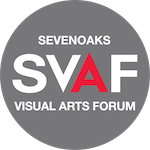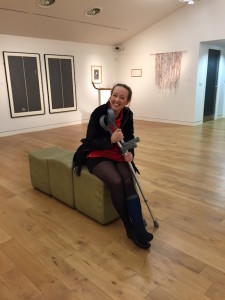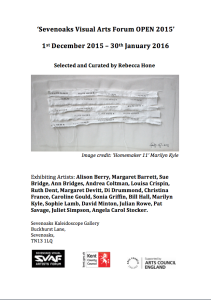
Julian Rowe
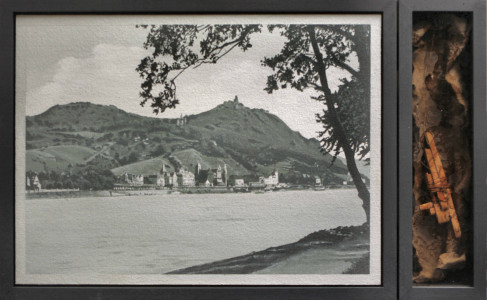
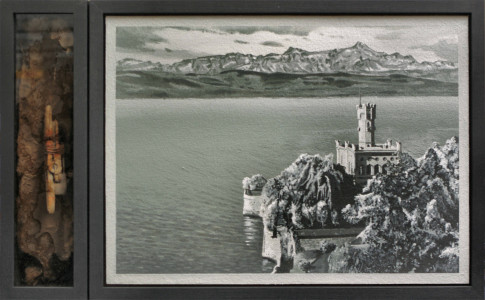
‘These two pieces arise from my continued fascination with the German Romantic movement and its consequences. I have a small collection of old German tourist postcards depicting the Rhine and other waterways. Most include images of paddle steamers, which close inspection invariably reveals to have been either badly drawn or photo-collaged onto the original image. In Flosshilde and Wellgunde I have made paintings of two of these postcards, removing the steamer images, and replacing them with little resin boats in the adjoining compartments.’
Sue Bridge
[arve url=”https://vimeo.com/143184421″ maxwidth=”500″ /]
‘Visiting time’ explores the experience of visiting a relative in hospital with dementia. It probes the awkwardness felt by visitors, and the loss of dignity for the unaware patient. I created the works as gouache paintings
and then animated these in After Effects software, adding real audio from the ward’.
Alison Berry
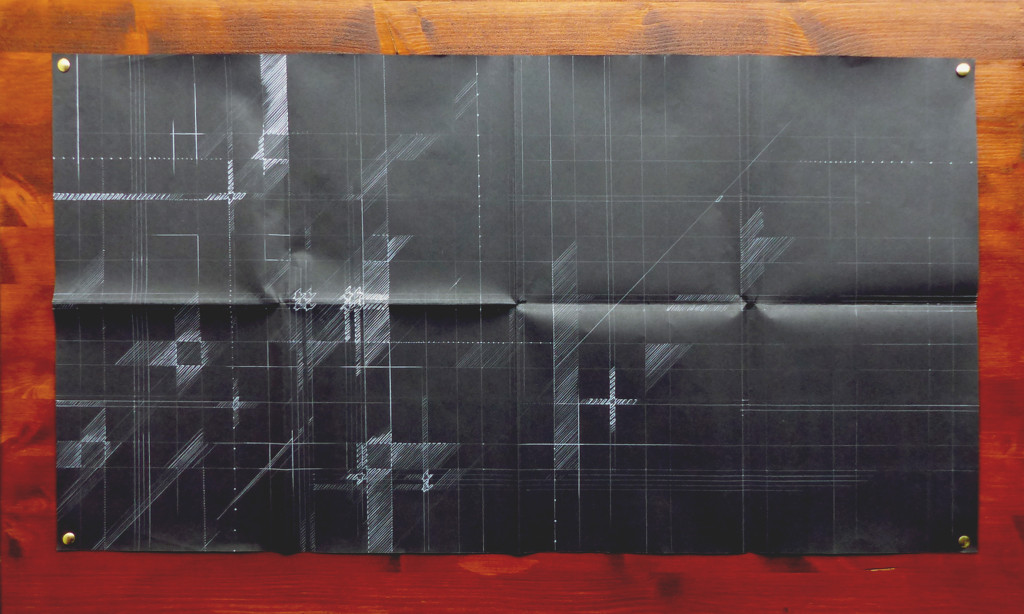
In this “plan” white pencil outlines the distinct woven shapes found in tartan fabric giving them an alien space invader appearance. Together with the diagonal lines stretching into blank areas of black paper and notched scales of measurement, the plan has the feel of proposals of infinite scale drawn in chalk on a black board by a professor of astrophysics.
Interestingly, the complex patterns in tartan are formed by simply repeating a sequence of colours in warp and weft thread. Plans are often unachievable, hopelessly unrealistic and naive, however, in this instance simple rules of repetition underlie complexity and execution is more straightforward than the plan.’
Ann Bridges
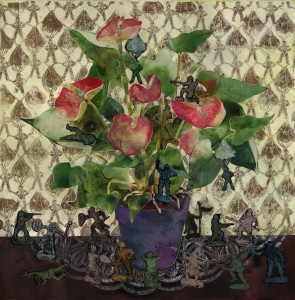
‘When I am grown to man’s estate
I shall be very proud and great,
And tell the other girls and boys
Not to meddle with my toys’
Robert Louis Stevenson (Looking Forward from A Child’s Garden of Verses 1885)
‘I am curious about the childhood experience of play time. It is the source of most of my ideas (and I like drawing toys)’.
Christina France
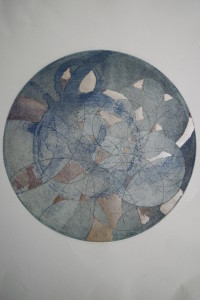
- ‘Ghostlines’ Etching on Somerset paper
‘The series Ghostlines, developed from an interest in my father’s experience as a young pilot during the latter part of WW11. His Log book, a valuable archive, provides insight into life as a fighter pilot.The underlying imagery developed in the series Ghostlines is drawn from photographs of a number of airfields constructed during the war years. Unnoticeable at ground level, from the air, the ghostly imprints reveal themselves.’
Louisa Crispin
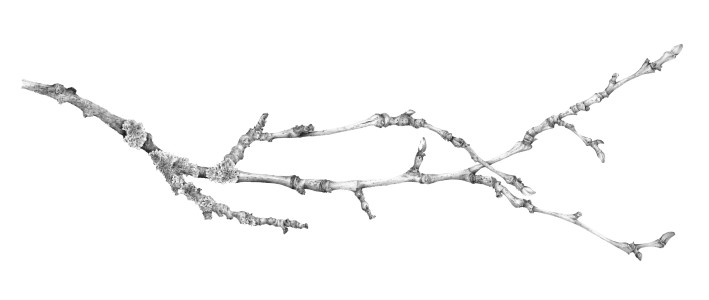
‘LOST IN A WORLD OF INTRICATE OBSERVATIONS FROM NATURE
A chance opportunity brought a small twig with tiny crab apples. Now I’m captivated by the way Lichen grows and enjoy searching for just the right stick, studying the detail before capturing it on beautiful smooth Strathmore Bristol Board using ultra sharp Staedtler pencils. I sit quietly in my Hut with Radio 4 wittering in the background, zoning out from the world around me as I look ever closer at plants, insects and birds. Texture, shadows, silhouettes & movement created with marks and tone, it’s rarely about the colour.’
Exhibition views:
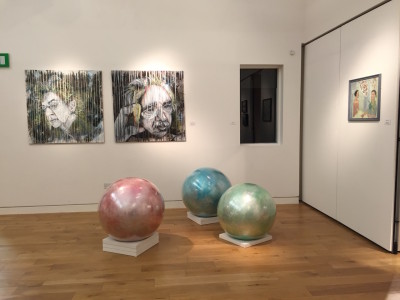
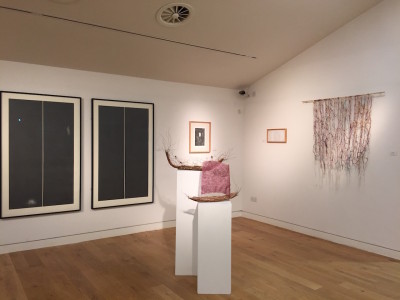
Andrea Coltman
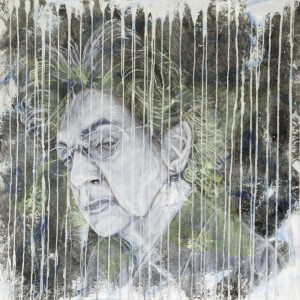
From a Body of Work entitled ‘Second Hand Smoke’
‘Remember Me – Hidden Child of The Holocaust (Erika Aged 72)’ Oil on linen
‘The title of this work is taken from a novel by Thane Rosenbaum. This book addresses the impact on the next generation of the children of Holocaust survivors. These words deftly describe the unspoken terror and guilt that is unwittingly passed on.
These paintings focus on my memories of my late father, Peter, and mother, Erika, ‘Hidden Children’* during 1944 -1945. My Father was smuggled to a farm in Lovaszpátona, 157km from his home in Budapest. At this time the Russian army were swarming over the Slovakian border on this insignificant area. In Budapest not only were the Germans invading and committing mass genocide, the radical Fascist party in power, The Arrow Cross, were systematically, ethnically cleansing on their own, more appalling, terms. Many children remaining in Budapest would have been hidden by whatever way possible, including my mother. All of them scarred by the events surrounding their missed childhood.
*Out of the millions of Jewish children born in Europe between 1933 and 1945, only 11% survived. 98% were Hidden Children making my family little miracles.’
Sophie Lamb
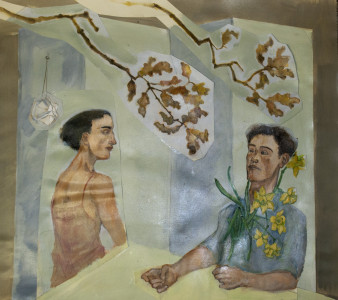
‘Conversation: part remembered’
‘This work is part of a practice which is based about many things, and also about nothing itself. It is about the production of the symbol in a space independent of reality. The symbolic image allows for rearrangement and permutation. Repetition allows for endless rereadings of interpretation. Repetition eliminates the extraneous and focusses the gaze inwards. The image conveys a mood rather than describing a narrative.
As opposed to art as a mirror to the world, the symbolic image turns the mirror inwards resulting in a closed feedback loop. The conversation exists only within the plane of the composition. The work promises nothing. The void behind the plane of the picture suggests further space and further meaning which does not promise to be fulfilled’.
Bill Hall
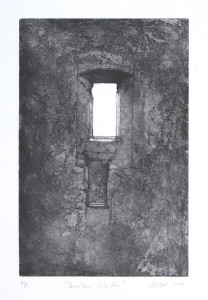
‘This work grew out of my time spent around the disused and nettle-encroached buildings which surround what was my grandparent’s old smallholding in the West of Ireland. Absorbing the ‘sense of place’ and the passage of time was an essential part of the process of visually recording these and other derelict sites. In etching, the repeated application of grounds, aquatints, and acid onto copper plates, have in turn become an attempt to convey the atmosphere and layers of time of neglected or abandoned places, and the various ‘weeds’ which now thrive in deserted sites of human activity.
Artist residencies in Ireland, Yorkshire and North Wales, as well as exploration of the quarries and lime kilns of the North Downs have enabled me to explore in increasing depth the themes of presence and loss evidenced by these remains.’
Marilyn Kyle
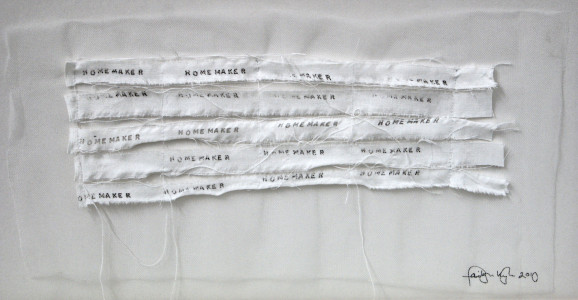
‘My work reflects problematic issues in peoples’ lives: the ‘Sanctity’ project developed from my experience of my adopted son, who is on the Autistic Spectrum, and my awareness of broader mental health issues. Homemaker II is part of a series which looks at Dementia: the awareness of which came with my mother succumbing to the disease.
Though rooted in printmaking I use other traditional processes and newer technologies dependent upon each project. My work (installations, objects, prints) is often visually enticing but, on closer inspection, contradictions emerge: a child’s delicate dress is torn, or, as in ‘Sanctity I’, the baby dolls are incomplete and damaged. I often use processes as forms of repetition. Though the cast dolls are repeated in ‘Sanctity I’, each element is individual. Likewise, in ‘Homemaker’ II, the fabric strips are only similar, not identical, and each repeated word, ‘Homemaker’, differs with each printing.’
Ruth Dent
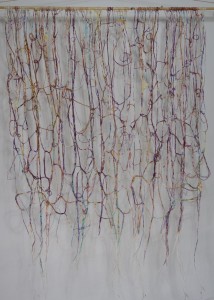
‘Intrigued by their appearance in her work, Ruth wrote: ‘grids represent a veil – allowing glimpses beneath, while distorting, hiding, shading, holding back. Is this something to do with the spirit – which is unseen yet it’s presence is felt, known, acknowledged and simultaneously hidden from view?’.
Originally, grids were windows: ‘a transparent vehicle, the window is that which admits light – or spirit – into the initial darkness of the room’ (1), whilst a ‘gridlike repetitive structure of verticals and horizontals is both rhythmic and suggestive of enclosure and imprisonment’ (2).
Finding grids in the woods, and asking if “a broken grid relates to breaking out?”, a chance donation of two skeins of linen thread precipitated this piece. Hanging a short distance from a wall, even more is ‘hidden’ as it becomes three-dimensional with its shadow’.
(1) – Rosalind Krauss: ‘Grids’ from The Originality of the Avant-Garde and Other Modernist Myths, MIT Press, 1986
(2) – Rosemary Betterton: ‘Bodies in the Work’ from An Intimate Distance. Women, Artists and The Body, Routledge, 1996
David Minton
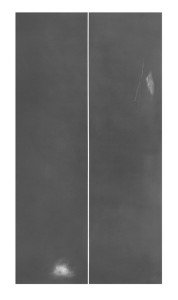
‘I mentally traced the marks from the first tentative recognition of my mother’s presence in my drawings, formed the grey graphite skin and damaged it. A loving damage? Wire wool rubbed a sore spot, a needle scratched and picked away, an erasion produced a surprising effect.The single central line does not compromise. Somewhere there may be a kindness, a nearly reaching out, but guarded so as not to be hurt, an angry kindness.’
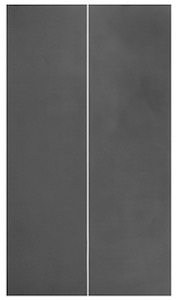
‘The notion of a ‘Straitjacket for a Child’ grew as I felt my way through the drawing. My mother died in January; as I worked, memories of her surfaced, the line forming umbilically from the supporting paper. Our relationship was not easy.’
Margaret Barrett

Margaret Barrett’s work is concerned with the life force inherent in all living things and in particular with an awareness of and care for the environment.
Influenced by Picasso’s attitude that any materials can be used….they don’t have to be precious metals and I don’t seek, I find, Margaret discovers her materials by chance. They are societies’ throw-away detritus and are deliberately gleaned from urban waste and industries’ left-overs. They are then re-cycled in her work and given an alternative life and meaning – a sense of history at the same time as considering the future of the planet.
Based on ideas and images from her drawings as well as the chance finding of materials, Margaret works intuitively, allowing her 3D pieces to develop organically at their own pace and take on dimensions dictated by the materials used. Her boats echo journeys. All inform and reflect her emotional response.’
Margaret Devitt
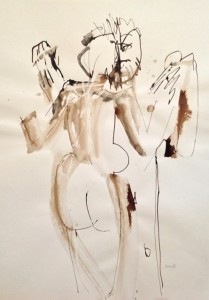
‘I am very much attracted to the spontaneity, and often humour, found in the work of young children.
Without hesitation or premeditation, and often with great immediacy, they convey their response to their surroundings. They are not concerned with ‘accuracy’ and yet somehow they manage to be astonishingly truthful to their subject.
These ink drawings are examples of my search to find again that state of playful participation’
Angela Carol Stocker.
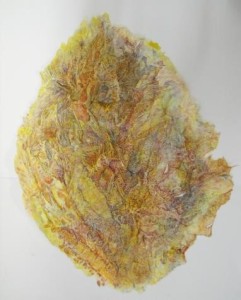
‘Fallen or floated along on the autumn wind, settled and resting on the gallery floor. Awaiting exploration and discovery its endless journey temporarily questioned. What is it?’
Pat Savage
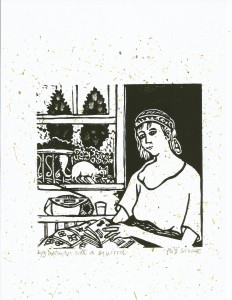
‘I create from the things I see around me and personal experience. Here is a friend in a nursing home with her regular daily visitor.’
Di Drummond
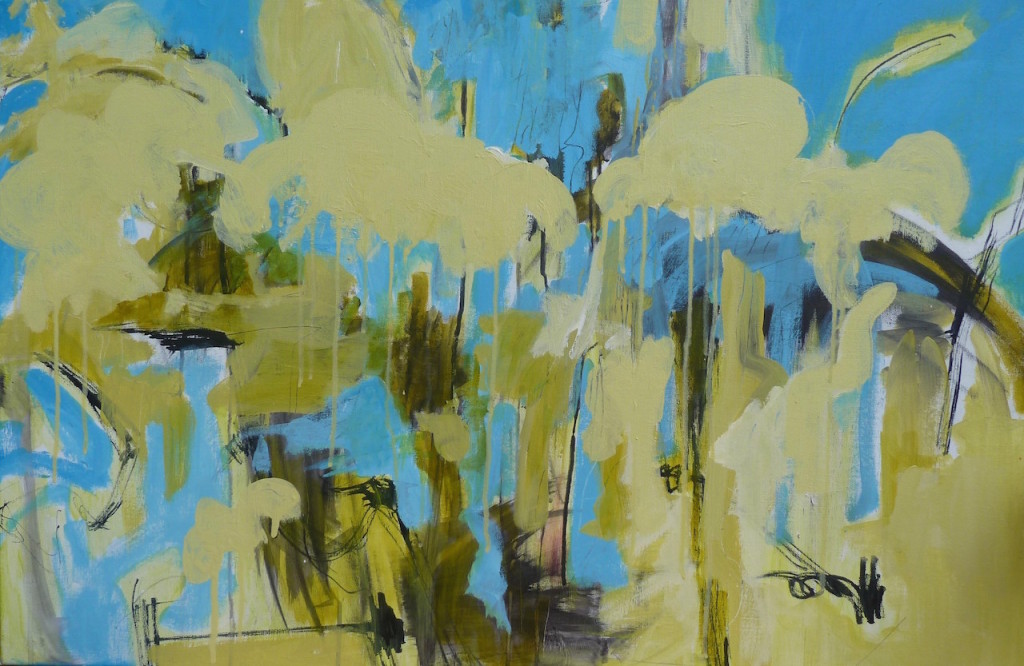
‘It was a Hard Rain’
‘I paint with expressive line and colour, without knowing what will happen or why. An image or form may emerge, perhaps subconsciously reflecting what I have been experiencing or thinking about. Work can also be a response to a particular event or idea. As the painting develops it can change radically from the initial mark making.
I work with acrylics, ink and charcoal, using brushes, twigs, fingers, feathers and palette knives, enjoying the physicality and immediacy of the paint and intense colour.
I tend to use square format to challenge the expectations of painting with landscape or portrait canvases.
My abstract work enables viewers to engage with the image without imposing a fixed narrative. A title may hint at the source but viewers are free to engage their own imaginations and experiences in reading meaning into the image.’
Caroline Gould
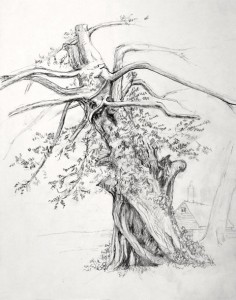
‘I have a deep respect for this tree with it’s estimated age of 500 years.
In admiring the tenacity of the species I endeavour to record the vigour with which these trees continue to renew themselves.’
Sonia Griffin

‘My practice is about consumerism, the shopping culture. how we operate within it, our global obsession with the product and what or who is the product. I’m ether attracted in some way be it admiration or irritation, to an idea or object and from there the work develops.
The piece explores the concept of how colour is used to sell a thought, ideal, to the consumer, such as a clean and healthy environment, life style and what we, the consumers, are challenged to believe is good, such as keeping our food, mind and body clean. Is this idyllic environment good for the environment and us as a whole?
3 Graces references the symbolic figures from classical mythology: goddesses of charm, beauty, and creativity.’
Juliet Simpson
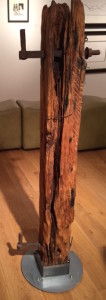
‘This oak post had lain for over 20 years in a wood, covered with leaves and not considered even worth chopping up for logs. When I forked it up it had almost split in half. I scraped away the remaining soft wood revealing the indestructible oak core. I discretely reinserted the gate hinge holders and treated it with hardener and Danish oil. It illustrated my age: scarred, full of crevices and wrinkles, with hints as to once having had a useful purpose, tough and enduring. So I mounted it on a turntable and left it as it was.’
This years selector and curator Rebecca Hone at the end of a long good natured curation and installation day of this years SVAF Open and all accomplished on one leg!
SVAF OPEN 2014
The Sevenoaks Kaleidoscope Gallery 5th – 15th November 2014
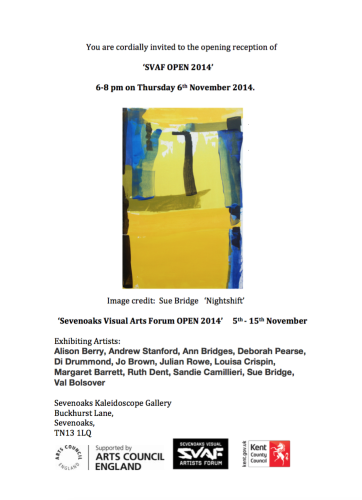
Selected by Kent Visual Arts Officer Duncan Brannan.
Curated by Duncan Brannan, Rosalind Barker and Susan Evans.
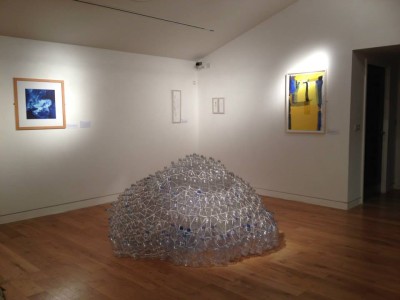
Margaret Barrett
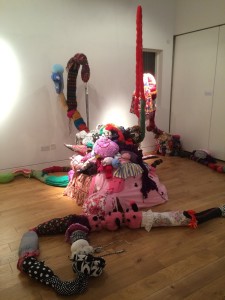 Sandie Camilliera
Sandie Camilliera
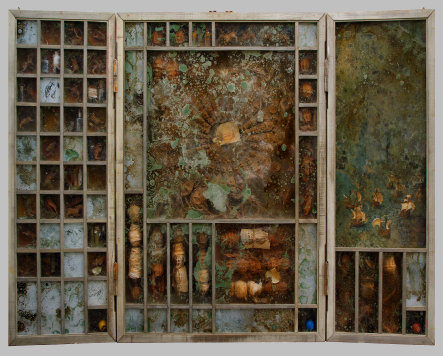
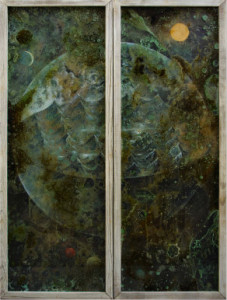
Julian Rowe
‘A man sets out to draw the world. As the years go by, he peoples a space with images of provinces, kingdoms, mountains, bays, ships, islands, fishes, rooms, instruments, stars, horses, and men. A short time before he dies, he discovers that the patient labyrinth of lines traces the lineaments of his own face.’ Jorge Luis Borges
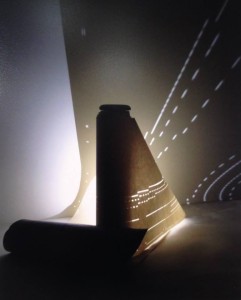
Alison Berry
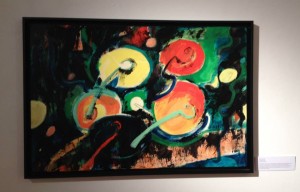
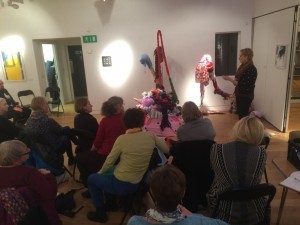
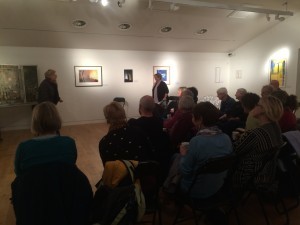
The selected artists talk about their work for 7 mins each at SVAF on 13th November 2014
